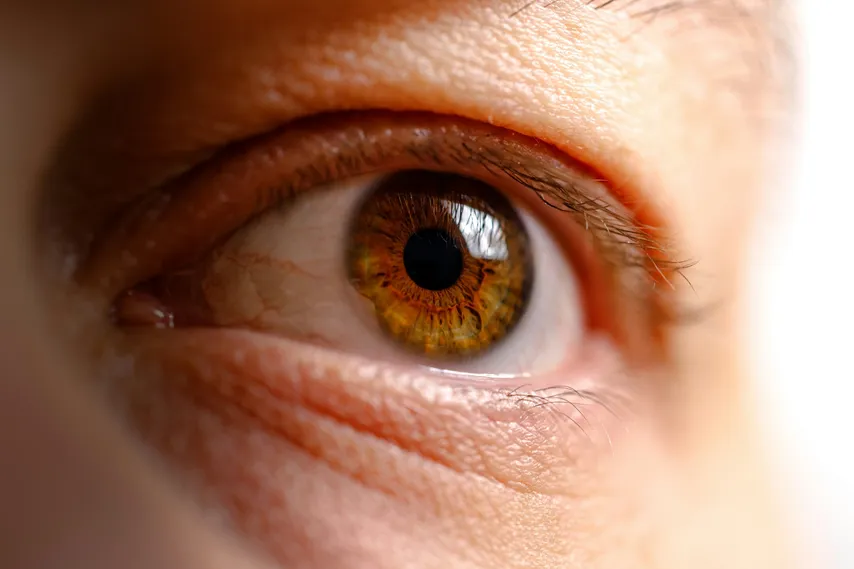Using eye-tracking software, two researchers from the Tokyo Institute of Technology watched players' pupils closely. While a hand of Texas Holdem played out on a computer, the pupils were measured, looking for patterns and trends.
Live poker players probably have hunches about the results. What do your pupils do when you make the nut straight and your opponent bets? Does the size of the bet make any difference?
Knowing this is interesting, but it's tough to lock eyes with everyone you play pots against. You'll need to see their pupils and understand their baseline size, which is tricky, but probably not impossible.
Let's talk about the study's goal, method, and final results.

The Link Between Emotion and Pupil Size
When emotions stimulate us, it impacts our pupil size. In this case, TV shows like Lie To Me and other Hollywood works aren't too far off. It wouldn't be out of the question for a keen-eyed onlooker to recognize changes in our pupils. Male and female pupils react similarly to the same stimulus, as the graphics below show.

It's interesting to see a large difference between male and female pupil size for happy and sad emotions. However, the general trends for both genders are the same; baseline pupil size increases based on different visual stimuli.
What about poker?
Imagine you've just turned top set. Your opponent is tossing more chips in the pot, stirring up various emotions. There's the thrill of hitting your set, excitement for the future pot you might win, and some apprehension. The river card could protect your hand and send the chips your way or complete their draws. All this runs through your mind, making your pupils do... what exactly?
A Study on What Your Pupils Say in Poker Games
In a 2024 Symposium on Eye Tracking Research and Applications (ETRA), two researchers from Tokyo addressed this. Using Texas Holdem and a player vs computer matchup, they tracked the pupil sizes of participants.
The paper is called, Impact of reward expectation on pupillary change during an adaptive two player card game, produced by Ryo Yasudo and Minoru Nakayama from the Tokyo Institute of Technology.
In a game of Texas Holdem, 10 male and female participants (average age of 22.1) played 32 hands of poker. Initially, each player got 1,000 chips and the option to fold, call, raise, or go all-in, but not check. Participants played all four betting rounds, from preflop to river. To keep the luminosity at a constant level and not influence pupil size, the game progress was shown in text format.

This gave the researchers 308 valid pieces of pupil data to work with. Pupil sizes were measured using an eye tracker called the Arrington ViewPoint and a chin rest.
Measurements were recorded:
- 3 seconds before and after a player made a move
- 5 seconds after the computer made a move
What Did the Research Show?
Ryo Yasudo and Minoru Nakayama's research showed a few main correlations:
- On the relationship between pupil size and amount bet:
"Pupil size increases significantly with the number of chips bet as an index of reward expectation."
The correlation coefficient between pupil size and the amount bet: (r = 0.57)
(The r= or correlation coefficient is a number between -1 and +1 that measures the strength and direction of a relationship between two variables)
In Figure 3, the researchers clearly show that when a player bets, the amount of chips they bet affects pupil size. Generally, larger bets appear to increase the pupil sizes of the players. The researchers state, "These results confirm that the pupil size reflects reward expectation"

We also see the relationship between player pupil size and the computer's bets. In this case, there's also a positive correlation, which the researchers speculate "may depend on the cognitive workload." It's unclear, but testing a professional poker player or online reg might produce very different results.
- On the relationship between pupil size and aggressiveness of betting:
"Pupil size reacts significantly to the aggressiveness of betting,"
To get a closer look at the relationship between the amount bet and the winning percentage, the researchers came up with another measurement. This is called the "aggressiveness of betting" in the study.
When a player has a high winning percentage (strong hand combination), it accelerates reward expectations. Betting high amounts, in this case, indicates a larger reward expectation. So, the aggressiveness of betting may suggest a belief in a high chance of winning or optimism. An example would be top pair with top kicker on a very safe board and betting for value.
Figure 2 shows the effect that the aggressiveness of betting has on relative pupil size.

The study solidifies the beliefs many poker players probably have. Pupil size may be changed when players are faced with likely wins, large bets, and higher payoffs.
If you want to look through the full paper, Impact of reward expectation on pupillary change during an adaptive two player card game is published online.
Can You Use Pupil Sizes to Become a Live Poker Pro?
To use these findings in your own live poker games, you'd need to know your opponent's baseline pupil size while being close enough to get a look. That's a tall order, especially if they are wearing sunglasses or hiding their face from you. In casino cash games or huge series like the WSOP, most players know to conceal emotions. They won't be locking eyes with you, giving you a chance to figure out their intentions.
And so, this study probably won't make anyone into an unbeatable live pro, but it's interesting nonetheless.

However, there are two large drawbacks to this study:
- The small sample size of just 10 participants
- The skill level of participants is unknown
If professionals were tested, it would be interesting to see if pupil size correlations were lessened, but that would be an expensive study. Perhaps, with experience and a deep understanding of the game, these physical reactions are reduced.
But at your weekend home games, friends might be a bit more expressive. See if you can spot any correlation between their play and pupils.
If you want to bring the home game online (for free) and use the same software online poker sites use, there's good news. You can choose one of the major brands and customize your own private sessions, for either cash games or tournaments. Adjust the settings, table sizes, timers, and even the stakes, then send invites out to the players. Our guide will explain all of the steps for hosting private online home games.



















